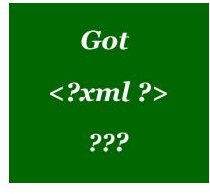XML Introduction - Part I
What is XML?
XML stands for Extensible Markup Language. However, this term may be misleading because XML is not only a markup language, but is simultaneously a metalanguage.
A markup language specifies the way information in an electronic document can be processed for use by another computer program, and it does this by denoting structure and content. It “marks up” the text, hence the name. HTML is an example, with its use of tags such as B (bold) and P (paragraph).
Metalanguages create programs that are used to perform calculations and required actions. Examples of such are C or C++ , and Java . XML is a metalanguage inasmuch as it is used to create XML based languages that are then used to create documents or files. For example, a mathematician may program in MathML, a businessperson in XBRL , and a musician in MusicML. When you yourself program in RSS or XHTML, you are also using an XML based language.
Many programs and applications today, from commercial ones such as Java Servlets, ASP.Net, and Sharepoint, to non-commercial ones such as custom made elearning software, depend heavily on XML documents.
So why and how is XML so useful and popular? A quick foray into its background is necessary to address this question.
A Brief History of XML
In the 1960s, GML (Generalized Markup Language) was created at IBM. Its purpose was to separate the instructions for formatting a document from the content inside the document itself. To ensure universal standards, SGML , which stands for Standard Generalized Markup Language, was developed by the American National Standards Institute (ANSI) in the 1980s. It was adopted by organizations such as the IRS and U.S. Department of Defense. SGML’s clear advantages lie in that it is device and system independent, and thus it is irrelevant whether it is used on a PC or Macintosh. However, it is so complex and expensive that not enough businesses can afford it. SGML nowadays is used mostly to create documents, and its most famous and successful application is HTML.
XML also derives from SGML. It was developed in 1996 under the auspices of the World Wide Web Consortium (W3C). XML is a successful child because it is inexpensive, powerful, fairly easy to use, and is also very flexible.You can place all sorts of data into documents that are created with it. This includes text, graphics, other documents, files, API, and of course, multimedia. The data inside these documents exists in a very structured format and is also presented in a well defined way.
This post is part of the series: XML for Everyone
This is a series of articles designed to teach basic XML to beginners. The prerequisite is a familiarity with HTML coding.
